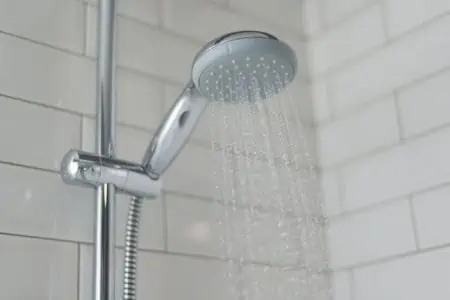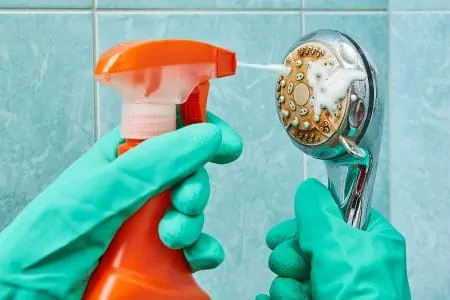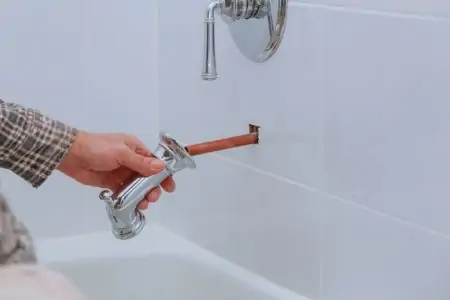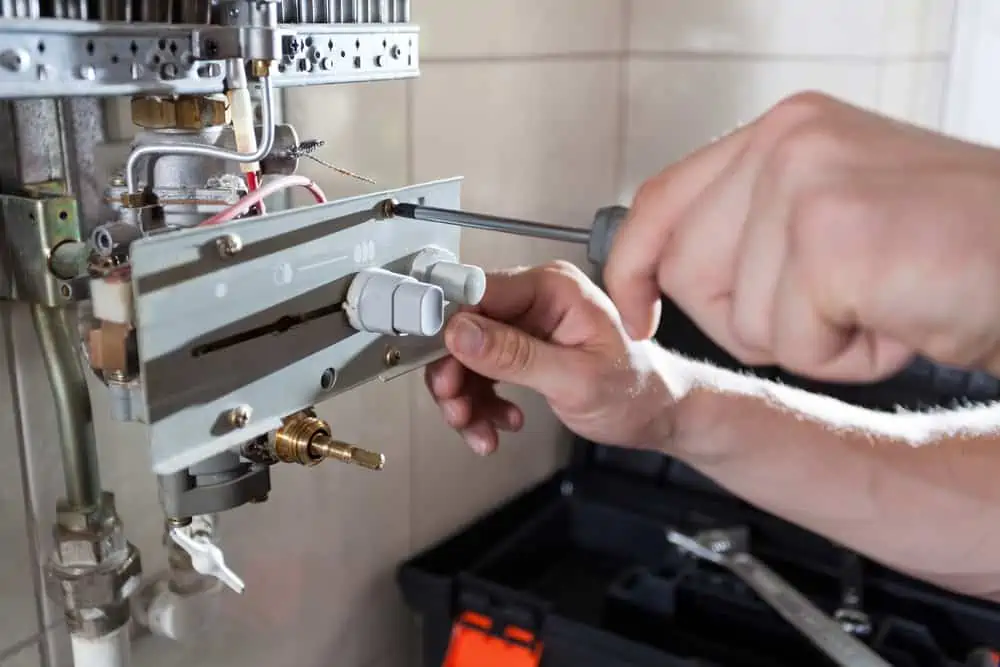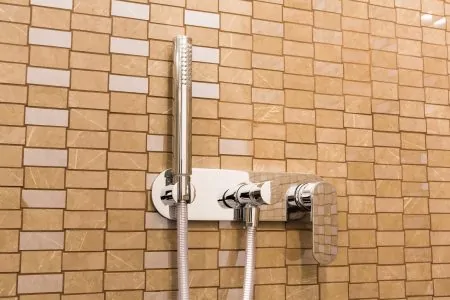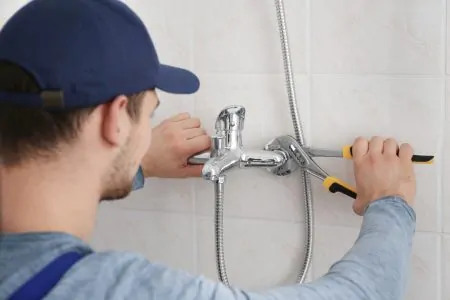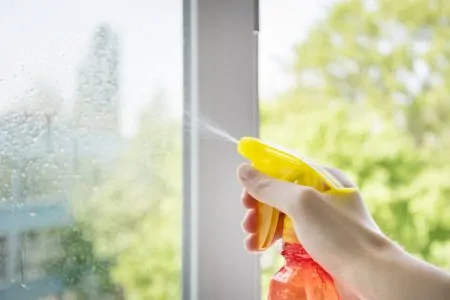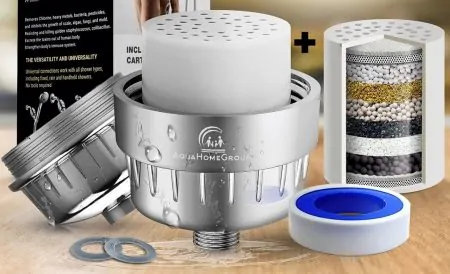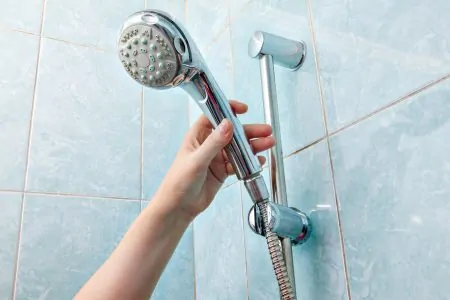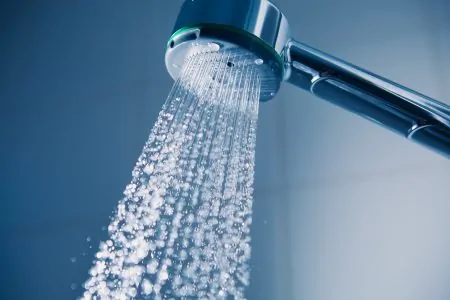As showers age, they start to make unfamiliar noises. One of the most common sounds is whistling or squealing. Ignore it at your peril because it could be a symptom of a bigger problem.
We answer, “why does my shower squeal?” and show you how to maintain your shower to prevent that shower squealing noise.
Key Takeaways
- Shower squealing can be caused by old or clogged showerheads, worn-out shower valves, and blocked shower pipes.
- Use white vinegar and water to clean showerheads and hoses, dissolving mineral deposits and limescale buildup.
- Regular maintenance, such as cleaning with white vinegar and checking shower cartridges, can help prevent shower squealing and other issues.
- For more complicated problems, like faulty shower valves or water heater issues, it’s best to consult a professional for assistance.
Why Does My Shower Squeal?
There are several reasons why your shower makes a high-pitched noise, and to drill down to the detail, we need to examine each one.
Old Showerhead
Everything has a shelf life, and that includes your showerhead. While it can last for years with the proper maintenance, if you notice a drop in water pressure, there’s a chance it’s got to go.
What’s Wrong
When the water pressure dips, it could be for several reasons. One of the leading contenders is a faulty showerhead. You may also notice the shower dripping when it is dormant, which is another sign it is nearing the end of its useful life.
How to Fix It
This problem is easy to fix. Swap the old showerhead for a new one. Unscrew the old head at the stem, where the hose connects, and screw in the new one. It’s best not to do this when the water is on.
Clogged Showerhead
Showerheads get clogged with residue over time. When that happens, you need to take action to prevent further damage to the showerhead and other components. The best way to check if it’s the showerhead making that whistling sound is to disconnect the head and turn the water on.
You know the showerhead is the culprit if the whining sound stops.
What’s Wrong?
Take a close look at your showerhead. If you see a white chalky residue on the surface of the head, there’s a strong chance that it has scaled up. It’s also possible that there are mineral deposits in the stem that connects to the hose.
How to Fix It
Remove the showerhead and hose and soak them in a bucket of vinegar and water. The vinegar dissolves limescale and cleans the showerhead and hose. Leave it to soak overnight to let the vinegar do its work.
Failing that, pour neat white vinegar into the showerhead and hose and leave it to sit for an hour. Then, reattach them to the shower and flush them through with water. If the screeching stops, you’ve solved the problem.
Top Tip
For added power cleaning, add a couple of spoonfuls of baking soda. It eats away at years of grime and limescale build-up, leaving you with a shiny showerhead.
Worn Out Shower Valve
Your shower valve could be the reason why your shower sounds like a kettle when the water is on. It is concealed behind the wall and controls the flow of hot and cold water and water pressure.
What’s Wrong?
If you notice the water pressure drop or a change in water temperature, your valve is almost certainly dead. It could also cause the showerhead to leak, or your shower handle might be hard to turn.
How to Fix It
Unless you have plumbing skills, it might be better to call in the pros to fix your shower valve. It does mean spending more money, but it will cure that loud scream your shower makes every time you use it.
Old Diverter Valve
Not all showers are walk-in stalls; some are tub showers. They are controlled via a diverter valve that changes the water flow from the tub faucets to the showerhead. When the diverter valve makes squeaky noises, it’s time to act.
What’s Wrong?
If you notice the water flow decrease, it could mean your diverter valve is failing to divert the water properly. One sure sign is when you use the shower setting, water still flows out of the tub faucet.
Your diverter valve is probably clogged if the showerhead is on, but no water comes through. It could also affect the water temperature with too much hot water or not enough.
How to Fix It
Most diverter valves are secured with a screw, which you can remove to reveal the inner components. Make up a mix of water and white vinegar and spray the inside of the diverter. Leave it to sit for an hour and then replace the diverter cover.
Turn the handle to loosen any stubborn limescale and flush the system with water. The other alternative to using natural products like white vinegar is to get a shop-bought detergent.
It may be time to replace the diverter valve but only do so if you know what you are doing. This Moen three-way diverter valve is ideal for all Moen bathroom suites.
Safety Note
If you use a chemical detergent, wear gloves, goggles, and a respirator to avoid unnecessary injuries.
Blocked Shower Cartridge
Just like other components of your shower, the cartridge (which connects the valve to the shower handle) can become clogged with mineral deposits and grime. It could be the cause of your squeaky shower.
What’s Wrong?
Cartridge valves have small holes that control water pressure and temperature. These holes can become blocked with mineral deposits and grime. You will notice a drop in the water flow, or it may run fast and then slow.
Your water’s temperature will also change rapidly, swinging from hot to cold. As debris gets stuck in the pipes, it makes a whistling noise.
How to Fix It
You will need to remove the handle and cover plate. The cartridge is held in place with a small clip. Remove the clip and pull the cartridge out with long-nosed pliers.
Invariably, it is easier to replace the cartridge with a new one. They are easy to get and cost around $30.
All you do is buy like-for-like, push the new cartridge into the opening, and reinsert the clip. Finally, replace the cover plate and handle.
Top Tip
Turn off the water before replacing a broken shower cartridge, and always lay a cloth over the drain to catch small items like screws.
High Water Pressure
Water pressure changes when it is forced through narrow spaces. Clogged pipes, showerheads, and valves could all be to blame. If water pressure changes throughout the house, consult with your water supply company.
What’s Wrong?
If you notice the water pressure increase, it could signify that water is being forced through narrower channels. Clogged pipes and valves are all signs of a water pressure issue.
How to Fix It
Some fixes are easier than others. Flushing through your hoses and showerhead is easy with white vinegar and water. Place them in a bucket and leave them to soak overnight.
You can easily replace the shower cartridge using the technique listed above, although only attempt this if you know what you’re doing.
You may be better off contacting a pro to fix your faulty shower valve if you have limited plumbing experience. It is more costly, but you get the peace of mind that the work is guaranteed.
Clogged Shower Pipes
As water flows through the shower pipes to the showerhead, it leaves mineral deposits that eventually harden and narrow the channel.
As the water squeezes through the gap, it increases the pressure. Eventually, as the pipe narrows further, it does the opposite and restricts the flow.
What’s Wrong?
If the water races out of the showerhead, the pressure could result from a narrowing of the shower pipes. If the pipes have silted up to the extent that water flow is restricted, your water will dribble out of the showerhead.
How to Fix It
The best way to remedy blocked shower pipes is to flush the system with water and white vinegar. Try removing the showerhead, pouring the solution into the pipe, and leaving it to sit. After an hour, attach the showerhead and turn on the water to flush it out.
Problems With Water Heater
Sometimes your shower is not the source of the problem. It could be an external issue relating to your water heater.
What’s Wrong?
Look for a drop in water pressure, extreme temperature swings, and loud whistling noises. Your water heater has a thermostat and heating elements that control the temperature. If these get clogged with mineral deposits, they could malfunction.
If that happens, the water delivered to your shower is disrupted.
How to Fix It
Unless you know about plumbing and electrics, it might be better to call a tradesperson to deal with the issue. Swapping heating elements and thermostats requires some knowledge, even if they are cheap to buy.
They are usually anchored by a few screws accessed via an inspection chamber on the outside of your water heater.
How to Maintain a Shower Regularly
Standing under a lukewarm shower is no fun. It’s better to prevent the issue rather than cure it, and the only way to do that is with regular maintenance.
Use White Vinegar
Spray the showerhead with white vinegar and water to dissolve any mineral deposits at the end of every shower. If they collect and harden, they block the showerhead.
Soak the Showerhead and Hose
Mix up a bucket of baking soda and water, immerse the showerhead and hose, and leave them to soak. This 100 percent natural mixture dissolves limescale and cleans the inside and outside of the components.
Check Shower Cartridges
Shower cartridges sit behind the shower handle and control water and temperature. They become clogged over time. Removing the handle and the cartridge means you can get access to clean.
It also means you can inspect the cartridge to decide if it needs replacing.
Take Note
Shower cartridges last for roughly two years on average, depending on whether you live in a hard or soft water area.
Deal With Drips
Drips are pretty harmless, but they could be the forerunner to more significant issues. If left, eventually, that tiny five-minute repair will cost you more money. It’s cheaper and easier to replace a perished washer than a shower valve.
FAQs
Deal With the Squeal
Showering is meant to be therapeutic, cleansing, and enjoyable. None of these things are possible if your shower squeals like a stuck pig. So, the next time you ask yourself, “why does my shower whistle?” it’s time to break out the cleaning products.
